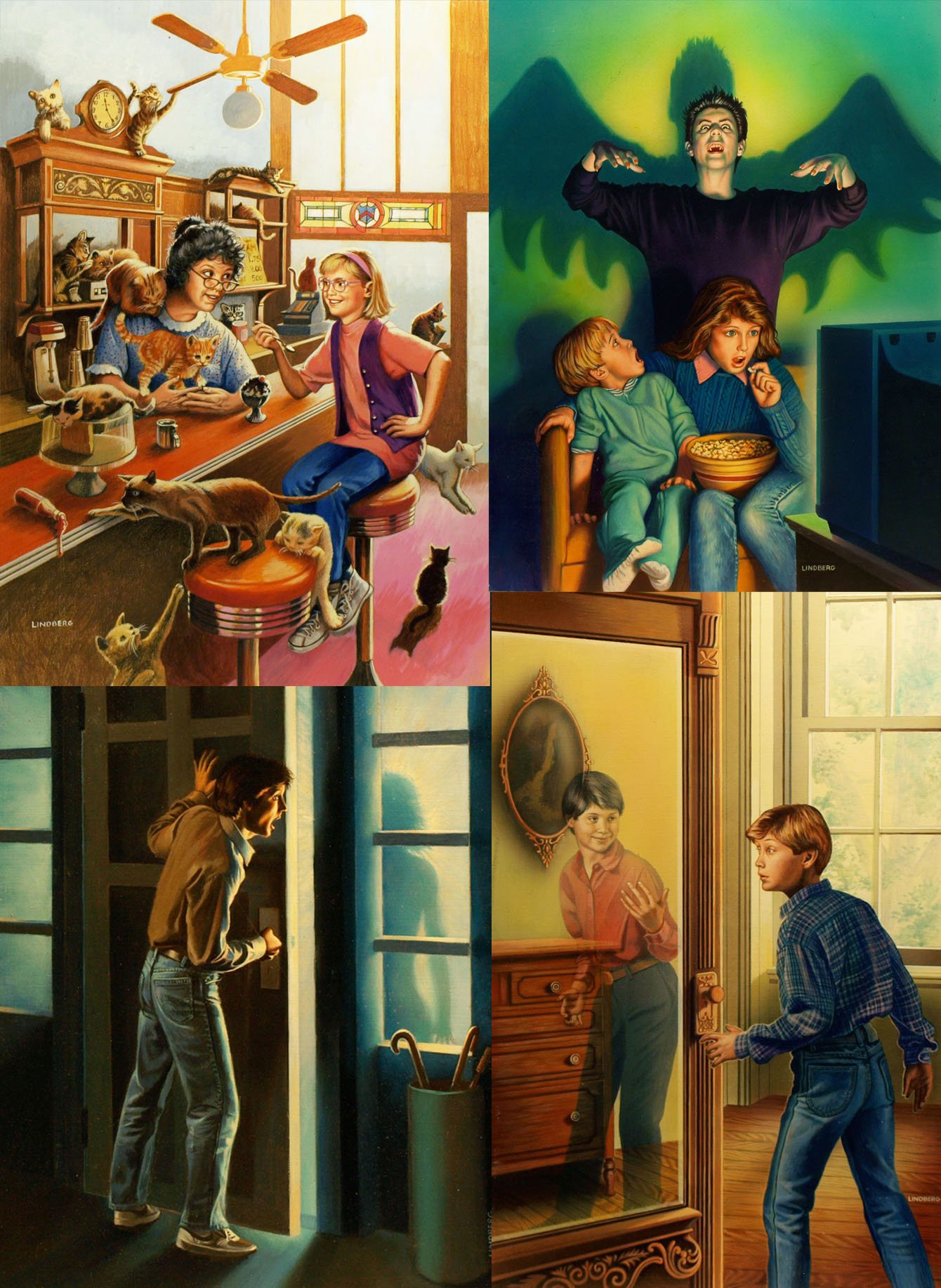My Illustration Process - Creating "Coney - A Trip to Luna Park"
Realistic Painting - working with photographs
When I began work on the final illustrations for my picture book, “Coney - A Trip to Luna Park” I had some decisions to make. As a children’s book cover artist, I’ve worked in a very realistic style and in general, I’ve worked professionally in a large variety of styles. What, then, was I going to do for this new picture book?
Illustration samples for the young adult children’s book market. See more samples at www.jeffreylindberg.com.
All illustrations ©Jeffrey Lindberg
Editors who worked on young adult mass market paperbacks wanted a very realistic approach to the illustrations, probably because they believed that might help readers to visualize the characters in the story. Most realistic illustrators at that time had photo shoots with live models, a practice harkening all the way back to golden age illustrators like Norman Rockwell.
“Saying Grace” Illustration by Norman Rockwell
My illustration process for book covers involved the rough sketch, final sketch, a photo shoot with child models, then prints of the best pictures that I would use as reference. Back then, I was working exclusively with acrylics and oil paints on illustration board. Working with photographs proved trickier than I had thought! At first, I found myself slavishly copying each detail of every photograph, and ended up working too tightly with no expression. I learned how to interpret the photo- and my work improved as a result.
Illustration ©Jeffrey Lindberg
Techniques used in Coney
Those days as a realistic illustrator are a counterpoint to my approach in Coney. Yes, I had long worked with photographs to achieve a level of realism that the YA cover market expected. Should I use photographs for the characters in Coney as well? I took some pictures of 2 of my grandchildren, who were around 10 years old at the time--a perfect age! I used myself as the model for the conductor and engineer. You can see in the example below how that approach would have worked.
“Trolley Trip to Coney Island”. Acrylic and oil on board. Illustration by Jeffrey Lindberg
The realistic working method using photographs is very time-consuming, and I knew that this picture book was going to be at least 32 pages long! (Ended up being 48 pages!)
So I decided to create about 5 double-page spreads in the full painting style. I then would illustrate a majority of Coney using my own style of drawing that comes straight from my imagination. I returned to the media that I used as a beginning children’s book illustrator- pen and ink with watercolors!
Initially I planned on scanning the ink drawings, and then color them using Photoshop. But I wasn’t happy with the results because the digital coloring just looked too, digital. This was going to be a book that visually represented the Coney Island of 1904! I needed a more traditional media for the color.
Watercolors were the perfect solution. The pooling together of the colors using wet in wet technique. The “happy accidents” that always happen with traditional media- color mixing will surprise you, but that’s the beauty of it. So every watercolor painting had to be scanned as a digital file to then be “finished” using Photoshop. Then tweaked the images to clean up the final art- without overdoing it and ruining the fresh qualities of the watercolor on paper.
Working with archival photographs
I began my search for images that depicted how Coney Island looked in 1900. Then I discovered the Library of Congress. The pictures that I found were absolutely amazing! They were so important in helping me to recreate the Coney Island of 1904. Here are some examples of the archival photographs, and how I used them in my illustrations.
Left: Luna Tower - photograph Library of Congress. Right: Luna Tower illustration in progress. ©Jeffrey Lindberg
Left: Ride in Luna Park- photograph Library of Congress. Right: Illustration using photo reference. ©Jeffrey Lindberg
The detailed images below show my work in progress. In creating the full-color paintings, my process starts with the pencil drawing, then I use colored pencils as a kind of under-painting. Acrylic paints are then used to develop the image further. Each kind of media has its own properties that work to achieve certain results. I have found that acrylic works best for me when I am looking to achieve a more graphic, detailed and realistic result.
Top images illustrations in progress using colored pencils and acrylic paint. Below image close-up of illustration using mixed media colored pencils and paint
The painter Andrew Wyeth is a good example of this approach. Even though he used egg tempera, and not acrylic paint, I believe that these 2 media have similar properties and applications. It’s interesting to note that Andrew Wyeth was also was an amazing watercolor artist, using brushwork that was much more loose and expressive than his egg tempera work. I believe that he used these 2 different media to achieve different purposes in his artistic expression.
Watercolor painting - Andrew Wyeth
Unfinished watercolor painting for Coney - ©Jeffrey Lindberg
Artists use the techniques that they have learned to express something that is inside of them. This could be a story, a moment in time- or simply just something that one feels can only be expressed non-verbally. I have used these techniques to tell my story about the Coney Island of 1904. For those of you who are interested in finding out more about Coney, I am offering a free pdf download of my book directly from my website. Please go to https://drive.google.com/file/d/1vjqcCknToO3E6MsujHTaSMXEiLYZqlFn/view.
When you have read it, please let me know what you think! I love to hear any and all comments. Thank you for your interest.








